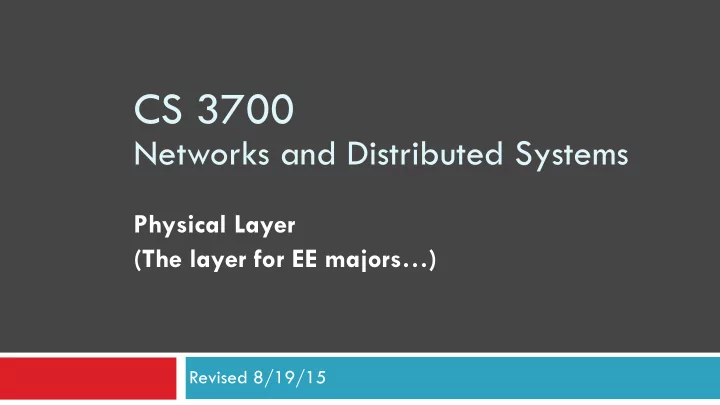

CS 3700 Networks and Distributed Systems Physical Layer (The layer for EE majors…) Revised 8/19/15
Physical Layer 2 � Function: � Get bits across a physical medium Application � Key challenge: Presentation � How to represent bits in analog ■ Digital computers work in binary Session ■ … but we live in an analog world Transport � Ideally, want high-bit rate � But, must avoid desynchronization Network Data Link Physical
Assumptions 3 � We have two discrete signals, high and low, to encode 1 and 0
Assumptions 3 � We have two discrete signals, high and low, to encode 1 and 0 � Transmission is synchronous, i.e. there is a clock that controls signal sampling Time
Assumptions 3 � We have two discrete signals, high and low, to encode 1 and 0 � Transmission is synchronous, i.e. there is a clock that controls signal sampling Sample Time
Assumptions 3 � We have two discrete signals, high and low, to encode 1 and 0 � Transmission is synchronous, i.e. there is a clock that controls signal sampling Sample Time � Amplitude and duration of signal must be significant
Non-Return to Zero (NRZ) 4 � 1 � high signal, 0 � low signal 0 0 1 0 1 0 1 1 0 0 NRZ Clock
Non-Return to Zero (NRZ) 4 � 1 � high signal, 0 � low signal 0 0 1 0 1 0 1 1 0 0 NRZ Clock � Problem: long strings of 0 or 1 cause desynchronization � How to distinguish lots of 0s from no signal? � How to recover the clock during lots of 1s?
Desynchronization 5 � Problem: how to recover the clock during sequences of 0’s or 1’s? 0 1 1 1 1 1 1 1 1 0 NRZ
Desynchronization 5 � Problem: how to recover the clock during sequences of 0’s or 1’s? 0 1 1 1 1 1 1 1 1 0 NRZ Transitions signify clock ticks
Desynchronization 5 � Problem: how to recover the clock during sequences of 0’s or 1’s? 0 1 1 1 1 1 1 1 1 0 NRZ Transitions signify clock ticks
Desynchronization 5 � Problem: how to recover the clock during sequences of 0’s or 1’s? 0 1 1 1 1 1 1 1 1 0 NRZ 0 1 1 1 1 1 1 1 0 Transitions signify clock ticks
Desynchronization 5 � Problem: how to recover the clock during sequences of 0’s or 1’s? 0 1 1 1 1 1 1 1 1 0 NRZ 0 1 1 1 1 1 1 1 0 Receiver misses Transitions a 1 due to signify clock skew ticks
Non-Return to Zero Inverted (NRZI) 6 � 1 � make transition, 0 � remain the same 0 0 1 0 1 0 1 1 0 0 NRZI Clock
Non-Return to Zero Inverted (NRZI) 6 � 1 � make transition, 0 � remain the same 0 0 1 0 1 0 1 1 0 0 NRZI Clock � Solves the problem for sequences of 1s, but not 0s
4-bit/5-bit (100 Mbps Ethernet) 7 4-bit 5-bit 4-bit 5-bit 0000 11110 1000 10010 0001 01001 1001 10011 0010 10100 1010 10110 0011 10101 1011 10111 0100 01010 1100 11010 0101 01011 1101 11011 0110 01110 1110 11100 0111 01111 1111 11101
4-bit/5-bit (100 Mbps Ethernet) 7 � Observation: NRZI works as long as no sequences of 0 � Idea: encode all 4-bit sequences as 5-bit sequences with no more than one leading 0 and two trailing 0 4-bit 5-bit 4-bit 5-bit 0000 11110 1000 10010 0001 01001 1001 10011 0010 10100 1010 10110 0011 10101 1011 10111 0100 01010 1100 11010 0101 01011 1101 11011 0110 01110 1110 11100 0111 01111 1111 11101 � Tradeoff: efficiency drops to 80%
4-bit/5-bit (100 Mbps Ethernet) 8-bit / 10-bit used in 7 Gigabit Ethernet � Observation: NRZI works as long as no sequences of 0 � Idea: encode all 4-bit sequences as 5-bit sequences with no more than one leading 0 and two trailing 0 4-bit 5-bit 4-bit 5-bit 0000 11110 1000 10010 0001 01001 1001 10011 0010 10100 1010 10110 0011 10101 1011 10111 0100 01010 1100 11010 0101 01011 1101 11011 0110 01110 1110 11100 0111 01111 1111 11101 � Tradeoff: efficiency drops to 80%
Manchester 8 � 1 � high-to-low, 0 � low-to-high 0 0 1 1 0 NRZI Clock
Manchester 8 � 1 � high-to-low, 0 � low-to-high 0 0 1 1 0 NRZI Clock � Good: Solves clock skew (every bit is a transition) � Bad: Halves throughput (two clock cycles per bit)
General Comments 9 � Physical layer is the lowest, so… � We tend not to worry about where to place functionality � There aren’t other layers that could interfere � We tend to care about it only when things go wrong � Physical layer characteristics are still fundamentally important to building reliable Internet systems � Insulated media vs. wireless � Packet vs. circuit switched media
Recommend
More recommend